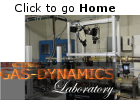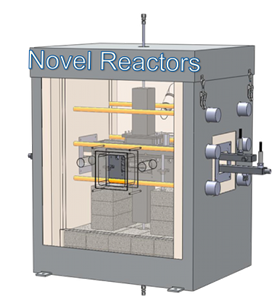Oxy Fuel Combustion
Fossil fuels account for nearly 80% of total U.S. energy supplies and nearly 90% of worldwide energy supplies. There is a growing concern that the use of fossil fuels and the associated carbon dioxide emissions are contributing to global warming. Oxy-coal combustion is a promising technology to address this issue.
An advanced oxy-fuel combustion power cycle that utilizes a pressurized coal combustor has been proposed. Coal is combusted in an environment of pure oxygen and recycled flue gases yielding flue gases of predominantly carbon dioxide and water under high pressure which eases carbon dioxide capture and sequestration. A system thermodynamic study shows that the flue gas thermal energy recovery by water condensation at elevated pressure enables the pressurized oxy-fuel system to achieve higher efficiency. This research project will also develop comprehensive modeling tools in the Computational Fluid Dynamics framework to design an advanced combustor for a clean, stable and highly efficient energy production.
CFD Study on Pressurized Oxy-Coal Combustors
Burning in an environment with mixed pure O2 and recirculated flue gas, the oxy-coal combustion shows new flame features such as ignition delay and destabilization because of the unique physical properties of CO2. Fundamentals of oxy-combustion will be studied systematically to understand these new features, and improve the combustion efficiency and environment performance.
A high fidelity Computational Fluid Dynamics (CFD) framework is implemented to study the flame regimes, flow patterns, and radiation heat transfers. Turbulence, radiation, chemistry-turbulence interaction and reaction kinetics will be simulated. Moreover, the coal water slurry atomized droplets fate indicates the importance of sub-models representing char particle size changes during the combustion processes, such as agglomeration, fragmentation and slagging combustion, which will be developed and integrated into the CFD framework.
Advanced designs of the oxy-combustor will be proposed and studied in the future.
Coal Particle Modeling in a Slagging Combustor
To achieve a reasonable agreement between simulation and the physical processes in the combustor, there is a need to model the evolution of individual coal particles. Starting with the characteristics of the parent coal particles, the model that is to be developed will trace the whole history of the particles (size, mass, porosity etc.) until the particle is burnt and its residuals exit the combustor. These processes can be categorized into three main processes -- devolatilization, char structure evolution and char consumption. The focus of the current work is to develop a char structure evolution model that predicts particle size and porosity after devolatilization, as well as to model char capture by slag and its devolatilization and consumption.
Chemical-Looping Combustion (CLC)
Chemical-looping combustion (CLC) is interesting and promising option of oxy-fuel combustion with complete CO2 capture. Its merits in the little efficiency penalty for CO2 separation attracts a lot of researchers.
In CLC, two reactors are involved. Fuel is introduced in the fuel reactor, in which it is oxidized by metal oxide. The reduced metal oxide is then transferred into the air reactor where it is oxidized. The flue gas from fuel reactor only contains CO2 and H2O and consequently carbon dioxide can be readily captured after steam condensation.
The focus of the current work is to develop a novel combustor based on the concept of chemical-looping. Experimental research focusing on the reactivity of oxygen carrier materials will also be carried out in the future.








